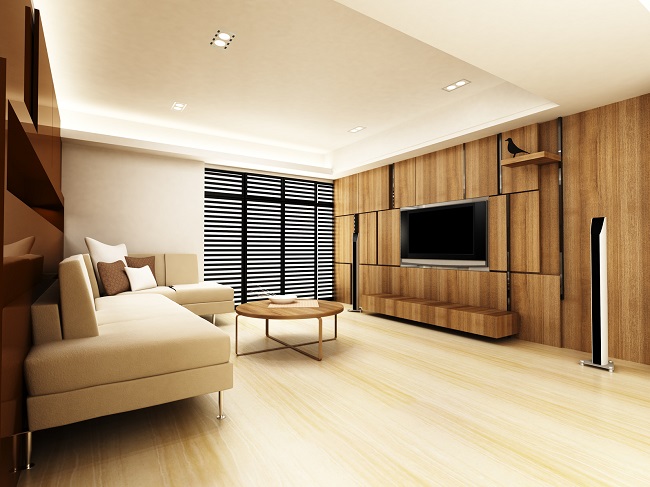
Installation Advantages of Acoustic Ceilings
Acoustic ceilings are becoming popular in all types of spaces. You will find acoustic tile ceiling in home, schools and organizations. In order to lower the height of current room, acoustic ceilings are used. Acoustic ceilings are installed to serve two very specific purposes. These acoustic plates can absorb sound waves to decrease the general decibel levels in a particular room. Additionally they can absorb certain frequencies of sound whose presence can make it difficult for the occupants of the room to hear with clarity. They reduce the sound reverberations of a room. Another purpose served by an acoustic ceiling is sound insulation. The acoustic panels reduce and remove any noise inside the room caused by external sources.

The Benefits Provided By These Ceilings
An acoustic ceiling can impart some useful advantages to the space it is installed in.
- Durability: These ceilings are highly durable. Acoustic type of ceilings can last for a considerable period of time provided the quality of the ceiling is good.
- Noise Absorbant: These ceilings have a high capacity for absorbing undesirable sounds. These ceilings help to dampen the ambient noise.
- The echo effect in rooms can be reduced and eliminated by the installation of these ceilings.
- The whole quality of sound in the particular room is improved by a considerable margin.
- The acoustic type of ceilings can eliminate the escape of sound from one room to another or from one floor to another.
- Acoustic ceilings are constructed from fire resistant materials which make the ceilings resist fire damage.
- These ceilings offer visual appeal as well by covering up the hard ceilings which can be unappealing to look at.
- Acoustic type of ceilings can hide all wires as well as pipes attached to the hard ceilings. Yet, those items can be accessed easily in case repairs are needed.
- Easy to fix: These ceilings are easy to fix to an unappealing room. The ceilings can be easily painted to ensure the décor of the room is not hampered in any way.
How do they work?
This type of ceiling is made up of the stick-build grid system and acoustic ceiling tiles. It is also called a lay-in ceiling which has many advantages like versatile, durable and cost-effective. One major benefit of acoustic ceiling is that ceiling tile can be removed without damage to the system and ceiling item above the system can be still maintained.
Applications
An acoustic ceiling can be put to use in a number of different projects. These building projects can be domestic, educational or marketable.
Residential projects involving the use of Acoustic Ceilings can be the following.
- Living rooms.
- Entertainment rooms in which home theatre systems or musical systems have been installed.
An Acoustic Ceiling can be used in the pitch of education in the following ways.
- Auditoriums
- Lecture halls
- Classrooms
- Audio visual rooms
- Sports rooms
Commercial uses of these Ceilings are mentioned below:
- Offices
- Conference rooms
- Boardrooms
- Sound studios
- Recording rooms
- Auditoriums
- Theatres
- Movie halls
- Shopping centers
The Selection of Acoustic Solutions for Ceilings
The choice of the acoustic ceiling will be primarily dependent on the specific needs and requirements of a user. It is important to determine what those needs are in order to ensure the maximum benefit is obtained from the acoustic panels installed in the ceilings.
The ceiling tiles are available in different design and textures. Most ceiling tiles are made from mineral fiber to reduce the noise. The maximum decibel levels faced in the particular room will determine the strength of acoustic panels required. These ceiling tiles are good at absorbing the sound and prevents in producing the echo. Additionally, it is important to recognize what the primary function of those acoustic solutions will be. Some acoustic panels are installed in order to eliminate the entry of external noise inside the room. Other acoustic solutions prevent the sound from inside the room from escaping outside. The area of the ceiling will need to be taken into consideration as the costs will rise proportionally to an increase in the area. The contractor must be contacted about the costs required for installation of the acoustic panels. The costs of purchasing those panels will need to be determined as well.
Disadvantages of Installing These Ceilings
- Stains can form easily when the panels get wet which look extremely unattractive.
- The stains caused can be removed but extensive bleaching will be repaired. In certain cases the panel will need to be replaced.
- Water can accumulate over the panels which will break and fall down when enough water has collected. This can take place unexpectedly and risk the protection of occupants.
This blog is planned to offer a helpful advantages about Acoustic ceiling. If you like the above-mentioned points about the Installing Acoustic Ceiling and get further info then contact us.
